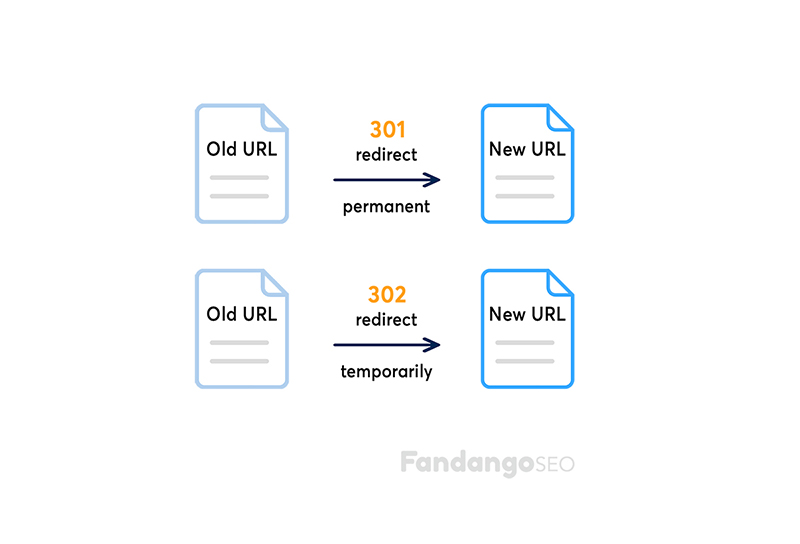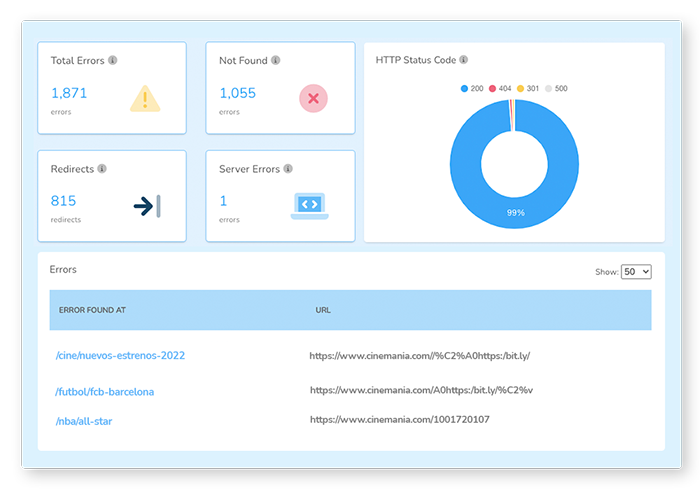On the Internet, there are many conversations and actions going on, but one of the most important ones is when a user asks their browser to visit a website. The information doesn’t just simply show up on the screen. Take a look at what’s actually going on behind the scenes.
What are HTTP status codes?
Once the visitor types in a URL or selects a page on the SERPs (Search Engine Results Pages), the browser will call his friend Server and say, “Hey, would you mind showing me this info?”
The website’s server can respond in many different ways, commonly known as response codes. These replies contain a 3 digit code that informs us of the status of the requested page at the time of the query.
In one sentence: an HTTP status code is the code the website server sends back to the user’s browser when opening a page.
This response can be “OK, here you go” or show any issue that either impede the user from seeing the page or delays the page load.
Why are HTTP status codes important for SEO?
When applying SEO strategies, you are looking for organic traffic interested in what your website offers. And to generate it, you need to make sure that search engines can access the sites’ content.
Well, when they request content from you, your goal is to return HTTP 200 Ok status. You don’t want to display 5xx and 4xx status codes, and you should minimize 3xx.
Web pages and crawlers understand each other through HTTP status codes. So if you have problems understanding them, you will have difficulties optimizing your site’s SEO.
Why? Because you will be able to see many things happening on your page, but if you cannot understand the HTTP status codes, you won’t know what is happening.
How to identify a response code?
HTTP response codes will always begin with a number from 1 to 5, initially presented as 1xx, 2xx, 3xx, 4xx and 5xx. Each range of numbers will belong to a server response (basically, a general issue), and will get more detailed depending on the numbers following the first digit.
You have probably encountered a couple of them when browsing around. What about the most hated 404 Not Found? Or the baffling 500 Internal Server Error?
In the next section, we explain each status code type in more detail.
Common HTTP status code types
There are over 40 different server status codes. But when it comes down to it, the HTTP errors that usually appear are reduced to a very limited number. Let’s see which ones they are:
1xx – Informational response.
These status codes show that the request has been received and understood but has not yet been processed.
Example: “We have received your request, and we are processing it. Please wait”.
2xx – Successful response
This code indicates that the request has been successful. The status code that you should mainly know within this range is HTTP 200.
Example: “Your request was successful. This is what you have requested:…”.
3xx – Redirect Response
Signals that require further action to complete the request. If a user receives a 3xx status code, they need to make a new request to the location returned by the server along with the redirect.
Example: “You are required to take further action to fulfill this request.”
4xx – Client Error Response
These status codes warn of an error made by the user. There are several reasons why they may appear:
- The client does not have the authorization to make the request.
- The page requested does not exist.
- Too many requests are being made.
Example: “The request cannot be completed. You may be doing something wrong”.
5xx – Server Error Response
It appears when the client makes a valid request, but the server has a problem completing it. This may be due to the server being under maintenance or too busy, among other causes.
Example: “We are having trouble processing your valid request.”
Most important HTTP status codes for SEO
You’ve probably already guessed it but yes, HTTP status codes do have an impact on SEO. It’s not enough just knowing which ones appear on a website; a good SEO expert should be able to spot them before Google or any other bot crawls them.
Most importantly, an SEO specialist should be able to fix all website errors in order to:
- Provide the best navigation experience for users, avoiding frustration with non-existent pages or long waiting times.
- Present an optimized page to search engines, keeping an optimal crawl budget to not waste their time and receive a better consideration, leading to stable rankings!
These are the types of status codes that are relevant to SEO strategy.
What does status code 200 mean?
Don’t panic, this is the best you can get! 😉 This code indicates that the page is properly displayed, with no server-related issues.
Remember that according to Google’s guidelines, all of the pages linked within your website will have to return a 200 code, which means that everything is OK.
HTTP status code 301
Any code that starts with 3xx refers to a page redirect.
The 301 response code means the page is permanently redirected. You’ll normally find more pages returning this kind of redirect because when you implement it into an old page, you tell the search engines to follow the new page, as the previous one will no longer be displayed.
HTTP status code 302
If you have HTTP code 302 redirects, you’ll have to make sure that they make sense, since they mean temporary redirection and the destination page will not be taken into account by the search engines, as they understand that the webmaster will go back to the older version once he’s done redefining the page. This isn’t good for SEO, so make sure to look at them carefully.

HTTP 400 status code
There are two types of status codes that start with 4xx:
- HTTP status code 404 Not Found: these are the pages that no longer exist or that are inoperative but keep receiving links, and that’s why users and search engines found them.
- But if you are never going to fix these pages, assign them a 410.
HTTP status code 410
This code means that the host has communicated with the server, but the requested file has been deleted.
A sentence such as “The requested resource has disappeared and will not return” will appear.
It is important not to confuse this with error code 404, which says that the file was not found.
HTTP status code 429
The server generates this when the same user has sent too many requests during a certain period of time. It may also happen that scripts or bots are trying to access the page.
A message such as “Too many requests” is displayed.
HTTP status code 500
This is a generic code that signals an internal server failure. You’ll see a message like this: “There has been an error on the server, and the request could not be completed.”
In other words: something went wrong on the server, so the requested resource was not delivered. This happens mainly for the following reasons:
- The connection to the database is broken.
- PHP is faulty.
- Third-party plugins.
HTTP 503 status code
An HTTP status code 503 indicates that the server is currently unable to handle the request because of temporary maintenance or overloading, so the page will be back soon. In this case, the server is out of order because changes are being implemented and they need to shut down for a while.
With the status code 503, Google understands that there’s a temporary error and the page will load later. For this reason, a 503 error isn’t a big issue.
How to check the HTTP status code?
You can check your website’s HTTP status codes using the Google Search Console. To do this, you need to request the codes of a specific address via the URL inspection tool. You will see the status code as the “Page fetch” results.
However, for faster and more accurate analysis, it is advisable to use a Website Crawler like FandangoSEO. The tool allows you to immediately check the status code that your pages return when Googlebot accesses your site. This way, you don’t have to analyze page by page in GSC. Plus, the tool also monitors your site and sends you email notifications alerting you of any problems that may harm your SEO performance.

How to fix HTTP status codes?
Once you’ve listed all the errors, try to understand why they happened on those specific pages. They could be the consequence of an action made by another team or the result of an SEO strategy that wasn’t planned correctly.
Wherever the error is coming from, you’ll have to find a solution to fix it, here are some suggestions.
- Implement a custom 404 page with the corporate image and some links back to the main categories or the homepage: this way, you’ll keep visitors browsing around your website.
- You don’t want users to encounter a 404, so try to send links pointing them to pages that do exist!
- Assign a 301 redirect to the 302 if it shouldn’t be considered temporary.
- Add a 410 to the pages that shouldn’t be found by Google anymore, but watch out! This is a major action. Most of them will be orphan pages, but make sure they aren’t receiving any relevant links.
- When it comes to server errors there are not many things an SEO Professional can do, so get in touch with your developers to solve these.
- Use an SEO Crawler to diagnose site errors fast and minimize the impact on the SERPs. Every webmaster must understand all status codes, so using a very comprehensive tool helps even the least experienced website owner.
Try FandangoSEO to get a clear understanding of errors and to track fixes. You can export the affected pages to ease the process and track their progress by comparing them to previous crawls.
